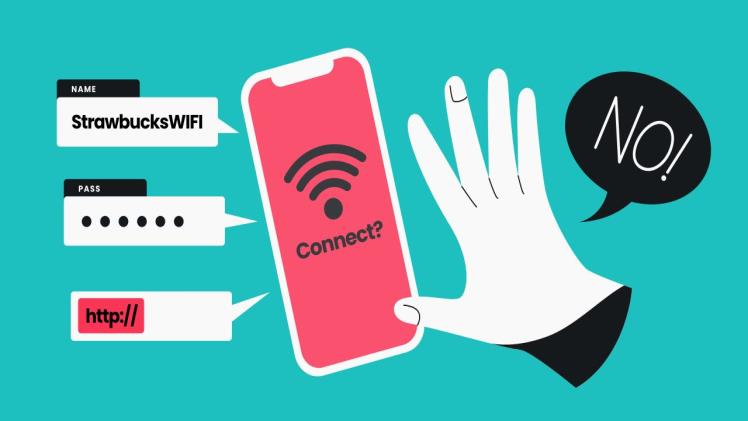In 2025, public Wi-Fi is nearly everywhere—cafes, airports, hotels, shopping malls, even parks. While it’s incredibly convenient, it’s also a significant security risk if not used wisely. Cybercriminals have become more sophisticated, making it easier to intercept your data or trick you into connecting to malicious networks. Fortunately, by staying informed and following some essential safety practices, you can protect yourself while enjoying the convenience of public internet access.
Why Public Wi-Fi is Risky
Public Wi-Fi networks are often unsecured or poorly protected, which makes them a prime target for:
- Man-in-the-middle attacks (MitM): Hackers intercept data sent between your device and the network.
- Evil twin networks: Fake hotspots that appear legitimate but are designed to steal information.
- Data snooping and packet sniffing: Cybercriminals monitor network traffic to extract sensitive information.
- Malware distribution: Infected networks can push malware or phishing links to connected users.
Top Tips to Stay Safe on Public Wi-Fi in 2025
1. Use a Trusted Virtual Private Network (VPN)
A VPN encrypts your internet traffic and hides your IP address, making it much harder for hackers to intercept or trace your activity. In 2025, VPN services are more advanced, with features like:
- Auto-connect on unsecured networks
- Multi-device protection
- Kill switch if the connection drops
Pro Tip: Choose a paid, reputable VPN provider. Avoid free VPNs—they often collect and sell your data.
2. Connect Only to Known, Secure Networks
Before connecting, verify the exact network name with the establishment’s staff. Avoid networks with similar or generic names like “Free Wi-Fi” or “Public_WiFi_123.” These may be traps set by hackers.
Tip: If a network doesn’t require a password, consider it a red flag.
3. Turn Off Auto-Connect and Bluetooth
Disable features like auto-connect to Wi-Fi and Bluetooth discovery. These can make your device vulnerable to unauthorized connections or tracking by malicious actors.
On most devices:
- Go to settings > Wi-Fi > turn off “Auto-Join.”
- Disable Bluetooth when not in use.
4. Enable Two-Factor Authentication (2FA)
Even if someone steals your credentials over public Wi-Fi, 2FA provides a critical second layer of defense. It requires you to verify your identity using a second method like a text, app, or biometric scan.
Best Practice: Use authentication apps (e.g., Google Authenticator, Authy) rather than SMS, which can be intercepted.
5. Use HTTPS and Secure Browsers
Only visit websites that use HTTPS (look for the padlock icon in the browser). Modern browsers in 2025 also flag insecure sites more clearly and may even block access to them by default.
Install privacy-focused browsers like:
- Brave
- Mozilla Firefox
- Tor Browser (for high anonymity needs)
6. Avoid Accessing Sensitive Accounts
Refrain from accessing bank accounts, shopping apps, or any service involving sensitive personal data while on public Wi-Fi. Wait until you’re on a private, secure network if possible.
Danger Zones:
- Online banking
- Credit card portals
- Tax or medical record platforms
7. Keep Devices and Apps Updated
Always keep your operating system, apps, and antivirus software up-to-date. Security patches in 2025 are smarter and often automated, but don’t ignore those update prompts.
Consider using:
- Reputable antivirus software with real-time protection
- Automatic OS updates on both mobile and desktop devices
8. Turn On Your Firewall
A firewall acts as a barrier between your device and malicious traffic. Ensure it’s enabled, especially when using public Wi-Fi. Most devices now offer simple toggles to turn firewalls on and off.
On Windows/macOS:
- Go to Settings > Security > Firewall
- Confirm it’s turned on for all networks
9. Limit App Permissions and Background Activity
Restrict app permissions to minimize background data exposure. Many apps run silently in the background and might transmit or sync data over unsafe connections.
Use your phone’s privacy settings to:
- Disable background data
- Restrict permissions to only what’s necessary
10. Use Encrypted Messaging Apps
For communication over public Wi-Fi, use end-to-end encrypted apps like:
- Signal
- Telegram (secret chats only)
These apps ensure your messages are only readable by the sender and receiver.
Bonus: Use eSIM or Mobile Hotspot When Possible
If you have access to mobile data, consider using a personal hotspot or an eSIM-based data plan instead of public Wi-Fi. This is one of the safest alternatives, especially for accessing sensitive information on the go.
Final Thoughts
Public Wi-Fi is convenient, but in 2025, cybersecurity threats have evolved along with it. Staying safe isn’t just about having antivirus software—it’s about adopting smart digital habits. By using VPNs, verifying network names, and keeping your devices secure, you can significantly reduce the risks associated with public internet access.
Stay cautious, stay updated, and browse smart.
FAQ: How to Stay Safe on Public Wi-Fi in 2025
Q1: Why is public Wi-Fi considered unsafe in 2025?
A: Public Wi-Fi networks are often unsecured or poorly protected, making them vulnerable to cyber threats like man-in-the-middle attacks, fake hotspots, and data snooping by hackers.
Q2: What is the safest way to use public Wi-Fi?
A: The safest approach is to use a trusted Virtual Private Network (VPN), which encrypts your internet traffic and hides your IP address from potential attackers.
Q3: Can I do online banking over public Wi-Fi?
A: It’s best to avoid accessing sensitive services like online banking or financial apps on public Wi-Fi. If absolutely necessary, always use a VPN and ensure the website uses HTTPS.
Q4: How do I know if a public Wi-Fi network is fake?
A: Fake networks, also known as “evil twin” hotspots, often mimic legitimate ones. Always verify the official Wi-Fi name with the staff before connecting, and avoid connecting to networks with generic names like “Free_WiFi” or “PublicNet.”
Q5: What features should a VPN have in 2025?
A: A good VPN should offer:
- Strong encryption (AES-256 or higher)
- A no-logs policy
- A kill switch
- Multi-device support
- Auto-connect on unsafe networks
Q6: Is using HTTPS enough to stay safe?
A: HTTPS adds a layer of security, but it’s not foolproof. For full protection, combine HTTPS browsing with a VPN, secure browser, and firewall settings.
Q7: Should I leave Wi-Fi and Bluetooth on when not in use?
A: No. Turn off Wi-Fi auto-connect and Bluetooth when not in use to prevent unauthorized access or tracking.
Q8: How can I tell if my device is compromised after using public Wi-Fi?
A: Warning signs include:
- Unusual pop-ups or ads
- Slow performance
- Unknown apps installed
- Changes in settings or passwords
Run a security scan with antivirus software if you suspect an issue.
Q9: Are there safer alternatives to public Wi-Fi?
A: Yes. Using a mobile hotspot or an eSIM data plan offers safer, private connections compared to open public Wi-Fi networks.
Q10: Do smartphones and laptops have built-in protection in 2025?
A: Most modern devices include firewalls, malware protection, and encrypted storage. Still, it’s essential to enable these features and keep all software up to date.







